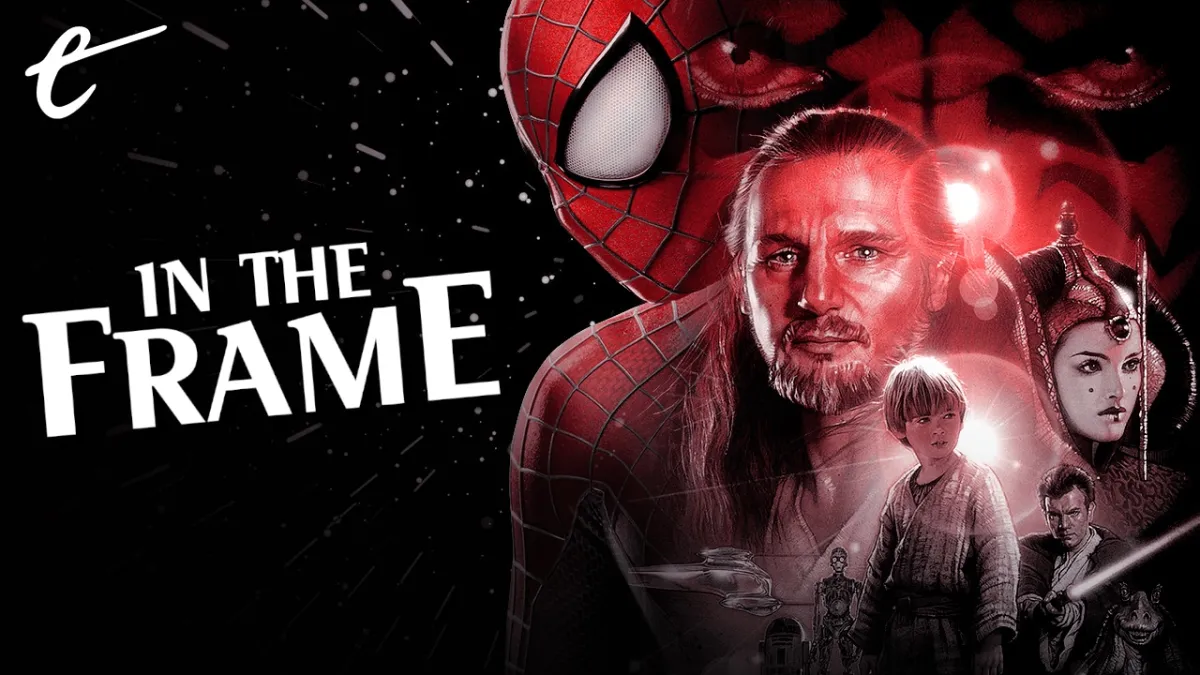This week’s episode of The Book of Boba Fett was notable for two things. First, it was a stealth episode of The Mandalorian. Second, it was built around a strange nostalgia for Star Wars: The Phantom Menace. Similarly, much of the discussion of Spider-Man: No Way Home has focused on the return of Andrew Garfield as a version of Peter Parker from the Amazing Spider-Man movies. This begs a question: Why is pop culture so nostalgic for things that it has made a spectacle of hating?
“Return of the Mandalorian” is saturated with references and callbacks to The Phantom Menace. Din Djarin (Pedro Pascal) gets himself a new spacecraft to replace the Razor Crest, and it is a modified Naboo starfighter from The Phantom Menace. He takes the ship out for a test drive and effectively does a lap of the pod race circuit from The Phantom Menace, even taking a trip through “Beggar’s Canyon.” He returns to the landing bay and admits that the joyride was “wizard.”
Similarly, Andrew Garfield has proved the unexpected breakout star of Spider-Man: No Way Home. There might even be an argument to be made that the film’s best performance was Garfield consistently lying about his appearance in the film, even to ex-girlfriend Emma Stone. More seriously though, coverage of the movie has singled out Garfield’s appearance as a highlight of No Way Home, providing a tether back to the Amazing Spider-Man films released in 2012 and 2014.
However, what’s interesting about these two prominent recent examples of nostalgia is that they are directed towards two pop culture objects that fans vocally hated at the time. The Phantom Menace was turned into a punchline on shows like The Big Bang Theory, The Simpsons, and Psych. The reaction of the established Star Wars fandom, which skewed towards horror, was captured in documentaries like The People vs. George Lucas.

To be fair, some of this reaction veered into the realm of self-parody. Jokes in Spaced spoofing the absurdity of fans’ outrage were indistinguishable from any random internet review. Still, there was a consensus that the prequels in general, and The Phantom Menace in particular, were terrible. Time named The Phantom Menace the second-worst summer blockbuster ever, behind only Transformers: Revenge of the Fallen. Even retrospective pieces conceded the film was “as bad as we remember.”
The reaction to the two Amazing Spider-Man movies was similar. Fans criticized Marc Webb’s Spider-Man reboot, particularly its choice to reinvent Peter Parker as “a rebel with a skateboard.” Given that Sony originally planned for the character to be into EDM and Snapchat, maybe fans were lucky. Critics wondered whether “the filmmakers actually read Spidey comics, or just glanced at them” and complained that the films turned the character into “the most boring superhero on film.”
The Amazing Spider-Man 2 is the only solo Spider-Man movie with a rotten score on Rotten Tomatoes. Both films placed bottom of IndieWire’s ranking of the Spider-Man movies in 2017. Excluding the bizarre choice to include Avengers: Infinity War and Avengers: Endgame in its ranking, Polygon placed the films at the bottom of its comparable list this month. Deadline described The Amazing Spider-Man 2 as “the most maligned movie ever that turned in a worldwide gross of $708.98 million.”
These properties do have their fans. There are people who adore The Phantom Menace and have enjoyed it since the moment that it was released. Similarly, there are many people for whom Andrew Garfield is and always will be their Spider-Man. This is great, and hopefully those people are enjoying seeing their love for these iterations of the characters validated. However, that affection does not reflect the prevailing fan narratives of these franchises.

There are similar questions raised by rumors about upcoming nostalgic projects. Doctor Strange in the Multiverse of Madness is reportedly filled with cameos from many maligned Marvel properties, with the studio even allegedly asking Ben Affleck to reprise his role from Daredevil. The film is rumored to include appearances from Nicholas Cage as Ghost Rider and Sophie Turner as Jean Grey, effectively reprising their roles from broadly disliked (and defunct) film franchises.
These sorts of appearances are often framed as “fan service,” even by those who enjoy them, and there’s a reason that videos of audience reactions to Tobey Maguire’s entrance in No Way Home went viral. However, what is the appeal in “fan service” built around things that it is widely accepted that this audience hated? Why are modern films and television shows so eager to evoke nostalgia for things that fans hated the first time around?
The most obvious point to make here is to acknowledge that nostalgia isn’t memory. In many cases, what is being evoked in these nostalgic franchise extensions isn’t anything resembling reality or history, but instead an imagined object. This often involves a crass distortion of the original object, in order to flatter the presumed audience. To pick the most obvious recent example, Ghostbusters: Afterlife turns an irreverent comedy into an object of achingly sincere reverence.
This is obvious in the way that No Way Home treats the elements carried over from The Amazing Spider-Man. There’s a discernible difference in how Now Way Home treats the nostalgic objects from Sam Raimi’s Spider-Man trilogy and how it approaches aspects ported over from the two Amazing Spider-Man movies. There’s a solid argument to be made that not only is Willem Dafoe the film’s most valuable player, but that the movie understands his take on Norman Osborn.

In contrast, elements from the two Amazing Spider-Man movies are distorted in the transition. Whatever one thinks of Jamie Foxx’s performance in The Amazing Spider-Man 2, Max Dillon was an actual character. In contrast, No Way Home isn’t interested in the particulars of Max Dillon, instead offering Foxx riffing on his familiar screen persona. The Amazing Spider-Man treated Curt Connors (Rhys Ifans) as a source of pathos, but No Way Home reduces him to goofy comic relief.
This applies to the treatment of Andrew Garfield’s take on Peter Parker. However one feels about The Amazing Spider-Man 2, the ending of that movie was about Peter picking himself up after the death of Gwen Stacy (Emma Stone). However, No Way Home insists that version of Peter must have fallen even further off-screen. When the other versions of Peter talk about letting people die, Garfield’s version concedes that, at some point, he “stopped pulling (his) punches.”
The implication of that scene — although not explicitly articulated — is that this version of Peter may have killed people after the upbeat ending of The Amazing Spider-Man 2. It’s a choice that plays into the vague and nostalgic memory of the Amazing Spider-Man films as “dark, edgy” takes on the character, ignoring the actual point of the film itself. Then again, as the recent Scream sequel demonstrates, perhaps the vague fan memory of the thing is more important than the original thing itself.
After all, Andrew Garfield’s appearance in No Way Home is largely conciliatory. Tobey Maguire’s middle-aged version of Peter Parker is presented as an ideal, a character who has got everything together. It’s a portrayal that contrasts the much more narratively interesting take on a middle-aged Peter Parker (Jake Johnson) in Spider-Man: Into the Spider-Verse. In contrast, Garfield’s version is presented as insecure, eager to please, and apologetic. He’s quick to concede how “lame” he is.

This suggests a possible reason for this nostalgic reclamation of these long-maligned franchise iterations. This isn’t about celebrating these takes on the character. After all, despite Garfield’s enthusiasm, Sony is never going to let Marc Webb make The Amazing Spider-Man 3, because fans don’t actually want that. It’s nice to see Tobey Maguire in No Way Home and Michael Keaton in The Flash, but perish the thought of another Sam Raimi Spider-Man or Tim Burton Batman.
At best, these characters are used as props to assure the bona fides of the studio’s current roadmap for these larger franchises. In the best of all possible worlds, Garfield might make an appearance in the next Venom movie as “the big one,” the ex that every great romantic comedy sequel needs. There would be some value in that, particularly in validating Garfield’s own desires for the character, but it also suggests that bringing these versions back has little to do with celebrating them.
Instead, as the word “reclaim” implies, it is about staking ownership. It demonstrates that even the most maligned and hated versions of these characters are in the toy chest, that the studio can parade them as an asset, and that the fandom can vicariously share in that sense of ownership. It doesn’t matter that nobody actually liked these things. It’s more important to know that they belong to the studios — and, implicitly, to the fans. After all, these portrayals flatter fan nostalgia.
In a world where these multimedia companies are increasingly consolidated, where the market is pushing towards tighter vertical integration, and where even shareholder presentations have become a spectator sport, all of this feels like watching the rich kid showcase their expensive and expansive toy collection. They are in mint condition, often in their original packaging. It would just be nice if people were allowed to actually play with them.





